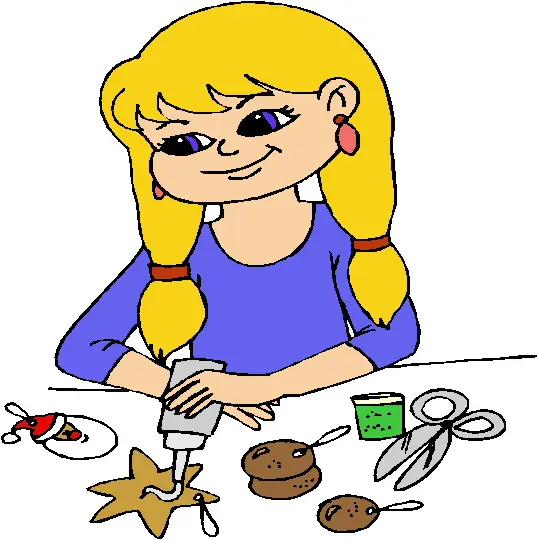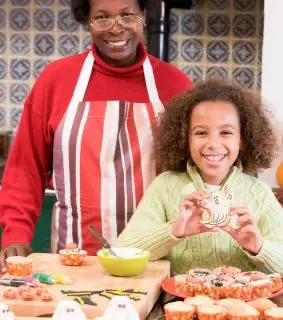Tips: Crafting With Children

Become involved in your children's arts and crafts activities. The first place to start is to value creativity in your own life. Each child should be provided with opportunities to create, explore, discover, and experiment through their own experiences to enable them to find their own unique place in this world.
Here are a few basic tips to make the process run more smoothly.
-
The best advice is to assume your kids will make a mess, and plan accordingly! Spill proof your craft area. Whenever possible, craft outside! In warm weather, messy children can run through a sprinkler to clean off before reentering the house. When crafting inside, protect all work surf. Use an old plastic tablecloth, newspapers or tarp on the table and floor. Place old towels on chairs.
Come to the craft area prepared. Look over the instructions and materials needed and plan ahead. A child will quickly grow restless if you don't.
Crafting doesn't have to be expensive. Recycle! Your creativity can add new life to old objects. Costume jewelry, lace, fabric scraps, buttons, and toilet tissue rolls are recycled staples for the young crafter.
Protect clothing. Use an adult's old long sleeve shirt or t-shirt, apron, or an artist smock that can be purchased inexpensively at department and craft stores. You can easily create a homemade smock by cutting head and arm openings from an old pillow case. Let the child write his or her name on it and decorate it as desired.
Very young children (1-3 years old) can craft safely and neatly in a highchair wearing little more than a plastic bib. I recommend a diaper or underwear as the preferred attire! A child of this age can finger paint (non-toxic products only) directly on the tray or can color using chunky crayons on a piece of paper that has been taped to highchair tray.
Allow ample space for each child and materials.
Select a project that is age appropriate. A child will soon become frustrated if the project is too difficult to complete.
Always provide close supervision, especially when sharp objects, such as scissors or messy paints are present.
don't rush. Plan ample time for preparation, activity, and clean up.
Rather than merely providing children with materials to work independently, craft as a family. Turn the TV off once a week and make an afternoon of it! Your children will look forward to this special time with you more than you will ever know. The pride that your children feel in their accomplishments will let you know that this has been an afternoon well spent.
Try to choose projects that are related to your child's interests.
Store craft items by categories in recycled plastic bins. A five gallon plastic ice cream tub with handle makes a great storage container. Items to store can include: ribbon, buttons, yarn, string, craft sticks, sequins, toilet paper rolls (always great to have on hand!) beads, fabric and paper scraps, paints, brushes, glitter, tape and glue, crayons, colored pencils, chalk, markers (washable, rubber stamps and ink, construction paper, scissors and paper punches, cookie cutters for templates and playdoh molds, and nature items.
Get involved in the kitchen by making non toxic recipes homemade craft recipes. Collect cookie cutters, small jello molds, measuring spoons and cups, and plastic dishes from yard sales for play dough fun.
Keep wet wipes on hand for picking up spills and clean up after.
Q-tips come in handy as paintbrushes and glue applicators.
Glue sticks are safe, clean and easy to handle by small fingers.
Purchasing paint in larger containers from a school or art supply store will be economical. To reduce costs, buy only primary colored paint--red, yellow and blue, which can produce a myriad of additional colors.
Use a toothpick (not for very young children) for picking up small beads.
Muffin tins, clean laundry soap scoops, film and yogurt containers make great reusable paint dispensers.
Plastic lids serve as reusable palettes. Paper plates and foam food trays serve as disposable palettes.
Allow children to craft often. This can't be stressed enough.
Never squelch their creativity. Let your child be creative without interfering. This will allow fun together while still allowing creativity to flourish.
When working with children, flexibility is the key! Don't suppress their creativity when they want to try something other than the original directions given for a project. And, above all, don't tell them that they did it wrong. Praise and encourage.
Plan crafting time when your child is well rested, after naptime or first thing in the morning. If your child seems to be inattentive or frustrated, it is better to take a mini break and come back to the project at a later time.
Attach a string across the play space and hang wet paintings with clothespins to dry.
Use visual aids. For drawing or painting projects, children often enjoy having something they can use as a visual reference. Clip magazine photos and illustrations of animals, people, flowers, etc. Most children have more success when they can actually see what they want to draw.
Don't take over your children's work and do it for them. There is nothing that can deflate their confidence and creativity faster!
Use the colorful tops from liquid laundry detergent to hold beads, pompoms, glue, glitter, paints etc.
Reuse dried up markers. Dip into water then paint on paper!
Are your kids learning something new? What better way to develop a growing mind than to make something they have never created before.
Most importantly, PRAISE, PRAISE, PRAISE and keep it FUN!
Kids Craft Club
Non-toxic Craft Recipes
Thanksgiving:
Turkey
<
Christmas:
Santa's Advent Christmas Count Down Calendar
Ice Cream Snow Cones
Rudolph
snowflakes
Holiday Handprint Wreath
Cinnamom Ornament
More Crafts for Kids
About Us- Contact Us - Privacy Policy©2023 TheParentVine.com a brand owned by GADL Enterprises, LLC. All rights reserved.
TheParentVine.com earns commissions on products sold.
| 


